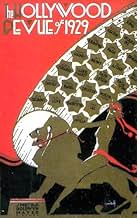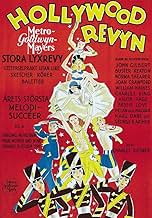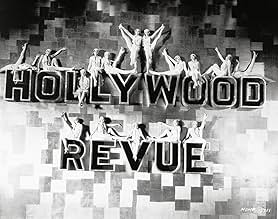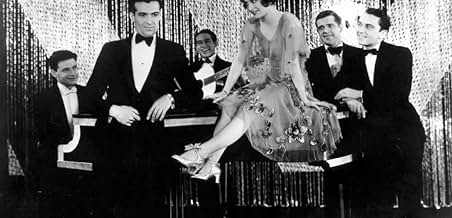IMDb RATING
5.7/10
2.4K
YOUR RATING
An all-star revue featuring MGM contract players.An all-star revue featuring MGM contract players.An all-star revue featuring MGM contract players.
- Directors
- Writers
- Stars
- Nominated for 1 Oscar
- 1 win & 1 nomination total
Cliff Edwards
- Ukelele Ike
- (as Ukulele Ike)
Nils Asther
- Nils Asther
- (scenes deleted)
Brox Sisters
- The Brox Sisters
- (as Brox Sisters - Singing Trio)
- Directors
- Writers
- All cast & crew
- Production, box office & more at IMDbPro
Featured reviews
This is the very first of the all-star, no-plot revues that proliferated during 1929 and 1930. Just about every star at Metro is featured, and there are many fun sequences to be savored in this film. The most famous one is probably the Joan Crawford segment, where she sings and dances to "Gotta Feeling For You". Her singing is passable, and her dancing is, well, "energetic". Marion Davies seems quite nervous in her "Tommy Atkins On Parade" number, but Bessie Love is pretty good in her wild acrobatics. Marie Dressler is fun, as always, and you can glimpse Carla Laemmle as the pearl in the oyster during "Tableau Of Jewels", which opens the second half. John Gilbert's speaking voice dosen't sound nearly as bad as had been rumored, even when considering the antiquity of the recording. The "Singin' In The Rain" number is fun, and offers a good contrast to the more famous one in the film of the same name. There are some special effects and two-color Technicolor that must have wowed the audiences back then, and it's been said that during the premiere, the theater put a gallon or so of orange-scented perfume into the ventilators during the "Orange Blossom Time" finale. In all, this film is well worth a look if you are into early sound films of historical value.
....suddenly it was decreed that everyone had to do one? That's what was happening in 1929, except it was naked voices, not naked bodies that were being revealed. No one could hear the stars talk, so they got to imagine what their voices were like. They also got to imagine what they were saying, or read it on the occasional title card. With sound, they heard the voices themselves and also the lines written for them. Conrad Nagel comes out sounding like the elegant gentleman he was. John Gilbert's voice is a little high pitched, (rumor has it that Louie Mayer, who hated him, had the sound track sped up), and effected. In his first film after this, he was asked to say "I love you, love you! about a dozen times during a love scene- a sequence parodied in "Singing in the Rain", and the audience laughed. Clara Bow revealed her thick Brooklynese, which seemed to belie her image as a gay party girl. Greta Garbo had a deep voice with a thick Swedish accent- just like the audience had imagined. Ben Turpin, the cross-eyed comedian, played against his image by playing swash-buckling heroes in the silents. Talkies revealed he sounded like he looked and made his films a little too ridiculous.
When you watch Hollywood Revue of 1929 and other films of that year, you are looking at some very nervous people who's recently minted stardom was threatened with extinction. And few of them made it. Those who did, like Joan Crawford, made it for reason not apparent in this musical review. In the early 30's, a deluge of stage stars like Spencer Tracy, Humphrey Bogart, James Cagney, Paul Muni, Katherine Hepburn, etc. would sweep them away and provide us with the stars of Hollywood's Golden Age.
When you watch Hollywood Revue of 1929 and other films of that year, you are looking at some very nervous people who's recently minted stardom was threatened with extinction. And few of them made it. Those who did, like Joan Crawford, made it for reason not apparent in this musical review. In the early 30's, a deluge of stage stars like Spencer Tracy, Humphrey Bogart, James Cagney, Paul Muni, Katherine Hepburn, etc. would sweep them away and provide us with the stars of Hollywood's Golden Age.
MGM used to boast that they had more stars than were in the heavens. This transitional picture shows some "stars", people who still have name recognition. Some of the performers were near the end of their career, some at the beginning, and others, probably did not have much of a career before or after this.
There's no real plot - it's pretty much a variety show hosted by Conrad Nagle and Jack Benny. There are some historical moments here - the first performance of "Singing in the Rain", the alleged cause of John Gilbert's career nosediving, Joan Crawford singing and dancing, some slapstick from Laurel & Hardy. There are appearances by the stunningly beautiful Anita Page who looks kind of sad while Conrad Nagle appears to be singing to her. William Haines, just before Louis B. Mayer ended his acting career, eating part of Jack Benny's clothing. Bessie Love appeared to come from one of Jack Benny's pockets - she said there was a $100 bill in the pocket, Benny quips that it's not his suit.
Parts of this was the inspiration of the movie "Singing in the Rain", which was done 20+ years later.
The pluses to this: some color sequences, including the closing performance of "Singing in the Rain", a weird dance sequence by Buster Keaton, who remains mute, and it's a great glimpse into Hollywood as it transitioned from the Silent Era to the age of "talkies". One interesting thing was the cameras weren't as static as they were for many of the early "talkies". There's also a kind of experimental dance sequence where it appears that they used some of the negatives in place of the processed film.
Some of the minuses are it wasn't a smooth transition from the Silent Era to the age of "talkies" - the sound quality is very inconsistent. Some people sounded kind of muffled, some people's voices weren't picked up very well. The version that was played by TCM on 8/4/08 wasn't closed captioned, so if you can't understand what someone is saying or singing, you don't have any captioning to help you out.
This is a good movie if you are interested in relatively early movies - it's almost 80 years old. It's also a chance to see some performers that didn't appear very often.
There's no real plot - it's pretty much a variety show hosted by Conrad Nagle and Jack Benny. There are some historical moments here - the first performance of "Singing in the Rain", the alleged cause of John Gilbert's career nosediving, Joan Crawford singing and dancing, some slapstick from Laurel & Hardy. There are appearances by the stunningly beautiful Anita Page who looks kind of sad while Conrad Nagle appears to be singing to her. William Haines, just before Louis B. Mayer ended his acting career, eating part of Jack Benny's clothing. Bessie Love appeared to come from one of Jack Benny's pockets - she said there was a $100 bill in the pocket, Benny quips that it's not his suit.
Parts of this was the inspiration of the movie "Singing in the Rain", which was done 20+ years later.
The pluses to this: some color sequences, including the closing performance of "Singing in the Rain", a weird dance sequence by Buster Keaton, who remains mute, and it's a great glimpse into Hollywood as it transitioned from the Silent Era to the age of "talkies". One interesting thing was the cameras weren't as static as they were for many of the early "talkies". There's also a kind of experimental dance sequence where it appears that they used some of the negatives in place of the processed film.
Some of the minuses are it wasn't a smooth transition from the Silent Era to the age of "talkies" - the sound quality is very inconsistent. Some people sounded kind of muffled, some people's voices weren't picked up very well. The version that was played by TCM on 8/4/08 wasn't closed captioned, so if you can't understand what someone is saying or singing, you don't have any captioning to help you out.
This is a good movie if you are interested in relatively early movies - it's almost 80 years old. It's also a chance to see some performers that didn't appear very often.
I have seen this film a few times and always think boy they were the good old days. In 1929, for their first talking film, MGM put together this lavish, all-star revue with absolutely no plot. It contains guest appearances from many of MGM's top silent film stars. If you do ever see this you will notice many of them did not make it through the transition of the talking pictures. Joan Crawford stands out doing her horrible dance and singing routine, but the best is the technicolor SINGIN' IN THE RAIN finale. This is a must for any film buff.
This is an amazing film, it has amazing special effects, it shows who made the transition from silent to talkie and who didn't, it has scenes in color (two-strip technicolor from what I understand), and it has some of the cutest costumes of any musical.
Some of the highlights of the movie are Joan Crawford song and dance number, which is too cute for words, and not terrible as another IMDB commenter would have you believe.
The Buster Keaton snake charmer dance is absoluetly hilarious. The Betty Johnson hiding in Jack Benny's pocket is pretty cute.
And the Singing in the Rain number is great, with it's simple yet beautiful art deco set and it's great reflective floor textured with the pitter patter of rain.
If you ever get a chance to see this film, take advantage of it. It is so strange to see every MGM start (except Garbo and Lon Chaney) in the same film, especially since many of them didn't continue making a lot of talking pictures.
Outstanding!!!!!
Some of the highlights of the movie are Joan Crawford song and dance number, which is too cute for words, and not terrible as another IMDB commenter would have you believe.
The Buster Keaton snake charmer dance is absoluetly hilarious. The Betty Johnson hiding in Jack Benny's pocket is pretty cute.
And the Singing in the Rain number is great, with it's simple yet beautiful art deco set and it's great reflective floor textured with the pitter patter of rain.
If you ever get a chance to see this film, take advantage of it. It is so strange to see every MGM start (except Garbo and Lon Chaney) in the same film, especially since many of them didn't continue making a lot of talking pictures.
Outstanding!!!!!
Did you know
- TriviaIn the "Singin' in the Rain" finale, Buster Keaton is shown carrying a small package in his left hand. This visual gag is a reference to Uneeda Biscuits, then a popular product made by Nabisco. The Uneeda Biscuit trademark showed a small boy wearing a yellow rain slicker and hat (similar to the outfits that the cast is wearing in this number) and walking home in the rain with a package of Uneeda Biscuits under his arm.
- GoofsAfter Cliff Edwards' opening number, one of the chorus girls in the background is chatting away with the girl next to her, when a sudden cut appears, and the same girl is now stone still (apparently the director told her in between to stop talking, and pay attention).
- Alternate versionsSome sources list the original running time of "Hollywood Revue of 1929" as 130 minutes. At least two sequences in the original roadshow version are missing from current prints: an opening recitation by the showgirls who are seen posing in the "Hollywood Revue" sign after the opening credits, and the appearance of Nils Asther, who assisted Jack Benny in introducing the final "Orange Blossom" number.
- ConnectionsAlternate-language version of Wir schalten um auf Hollywood (1931)
- SoundtracksSingin' in the Rain
(1929) (uncredited)
Music by Nacio Herb Brown
Lyrics by Arthur Freed
Played during the opening by The MGM Symphony Orchestra
Played on ukulele and sung by Cliff Edwards and The Brox Sisters; Danced by chorus
Sung by the major stars at the end
Details
- Release date
- Country of origin
- Official site
- Language
- Also known as
- Hollywood Revue
- Filming locations
- Production company
- See more company credits at IMDbPro
Box office
- Gross worldwide
- $5,277,780
- Runtime2 hours 10 minutes
- Color
Contribute to this page
Suggest an edit or add missing content

Top Gap
By what name was Hollywood chante et danse (1929) officially released in India in English?
Answer





































